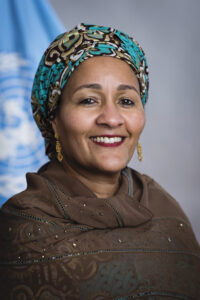Remarks from the Deputy Secretary-General of the United Nations at CPD57
Written by Amina J. Mohammed, Deputy Secretary-General of the United Nations | Published: September 9, 2024

Statement delivered at the 57th Session of the UN Commission on Population and Development (CPD57) on April 29, 2024, at the United Nations headquarters in New York, NY
This year marks the 30th anniversary of the adoption of the Programme of Action for the International Conference on Population and Development in Cairo in 1994.
As we take stock of progress and lessons learned, we must also seize the opportunity to accelerate action on the SDGs as well as look ahead to set priorities for the next 30 years.
In 1994, the world’s population stood at 5.6 billion. It is now over 8.1 billion, and it keeps growing. We must prepare for continued population growth in sub-Saharan Africa — and slow growth or decline in much of Asia, Europe, and Northern America, and later, in Latin America and the Caribbean.
Excellencies, we have achieved great progress in 30 years, and we must celebrate the glass that is some full: Fewer women are dying in pregnancy and childbirth; child mortality risks have fallen — across developed and developing countries; we have expanded access to reproductive health care services, including modern contraceptives; and rates of adolescent pregnancy have declined.
However, progress has been masked by those who have been left behind. Many countries still fall short of life expectancy targets, and many developing countries face significant challenges in reaching the SDG target for child mortality. Around the world, 164 [million] women of reproductive age — 8% — have no access to family planning services.*
While all countries are on the path toward longer lives and smaller families, some continue to face the challenge of rapid population growth. Others are grappling with the consequences of population aging, sometimes population decline. And we see our health systems struggling.
Excellencies, we must fully recognize the megatrends that are reshaping our world — climate change, demographic shifts, urbanization, digital technologies, and inequalities — as well as their critical connections to the Sustainable Development Goals.
We must remain vigilant and continue to address situations where sexual and reproductive health and rights are being rolled back. We must respond and push back when women’s rights are being eroded, and when migrants and other vulnerable populations are mistreated.
We must continue to uphold the dignity of all people, ensuring that no one is left behind. And we must support rights-based approaches in our population and development policies.
Major population trends for the coming decades are clear: continuing gradual reductions in fertility and mortality, the progressive aging of populations, and their ongoing concentration in urban centers both large and small.
Population aging requires a life course approach to health and to education. This means focusing on preventive care and lifelong learning to enable everyone to remain active and integrated in their communities. The inevitable rise in demand for longterm care calls for new policies and public funding that ensure decent conditions for care providers — most of whom are women.
Ensuring universal access to reproductive and health care services and the unimpeded exercise of reproductive rights will help meet the needs of family planning. At the same time, we must anticipate and provide for a growing need of assisted reproductive technologies, for the increasing numbers of young women and men who are having fewer children than they desire.
As we approach the 30th anniversary of the Beijing Declaration and Platform for Action in 2025, we must accelerate progress toward gender equality and the empowerment of women in all spheres of life. We cannot achieve our common goals if we leave half of humanity behind.
Looking ahead to the Summit of the Future, we must prioritize the needs of future generations. This means pursuing a green and sustainable development pathway so that they inherit a livable planet.
In a mobile and interdependent world, the international community must cooperate at all levels to facilitate an inclusive and rights-based approach. Youth, women, civil society, local communities, and small and medium size enterprises must be part of the process.
The Local 2030 platform supports the delivery of the SDGs on the ground and can help bring the transformative change that is needed. A strong political declaration by this Commission would galvanize action toward the full implementation of the ICPD Programme of Action.
Together, we can contribute to safeguarding rights, agency, accelerate the SDG progress, and support a sustainable future for people and planet, this keeping the promise of the 2030 Agenda. And leaving no one behind, let me add my voice to the tragedies that we see in Sudan, in Gaza, where the suffering of women and children should no longer be tolerated. We need to find our moral compass and come back to the rights of all women and young women and children in these tragic times. Thank you.
* 164 million is the estimated number of women in developing regions who have an unmet need for any method of family planning. The figure we typically use instead is 218 million, which is the estimated number of women in developing regions who have an unmet need for modern contraception. The difference is made up of women who don’t want to become pregnant but are using less effective traditional methods of family planning. There is another figure, 257 million, used in our statement on page 17, which is the estimated number of women globally who have an unmet need for modern contraception.
Ms. Mohammed’s speech begins at minute 12 of this CPD57 plenary session recording.
